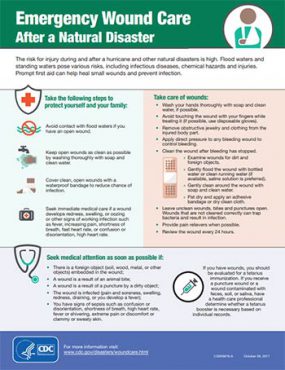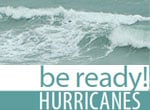Emergency Wound Care After a Natural Disaster

[NOTE: Health professionals should see Emergency Wound Management for Healthcare Professionals.]
The risk for injury during and after a hurricane and other natural disasters is high. Flood waters and standing waters pose various risks, including infectious diseases, chemical hazards and injuries. Prompt first aid can help heal small wounds and prevent infection.
Take the following steps to protect yourself and your family:
- Avoid contact with flood waters if you have an open wound.
- Keep open wounds as clean as possible by washing thoroughly with soap and clean water.
- Cover clean, open wounds with a waterproof bandage to reduce chance of infection.
- Seek immediate medical care if a wound develops redness, swelling, or oozing or other signs of working infection such as fever, increasing pain, shortness of breath, fast heart rate, or confusion or disorientation, high heart rate.
Take Care of Wound
- Wash your hands thoroughly with soap and clean water, if possible.
- Avoid touching the wound with your fingers while treating it (if possible, use disposable, latex gloves).
- Remove obstructive jewelry and clothing from the injured body part.
- Apply direct pressure to any bleeding wound to control bleeding.
- Clean the wound after bleeding has stopped.
- Examine wounds for dirt and foreign objects.
- Gently flood the wound with bottled water or clean running water (if available, saline solution is preferred).
- Gently clean around the wound with soap and clean water.
- Pat dry and apply an adhesive bandage or dry clean cloth.
- Leave unclean wounds, bites, and punctures open. Wounds that are not cleaned correctly can trap bacteria and result in infection.
- Provide pain relievers when possible.
- Review the wound every 24 hours.
 [PDF - 435 KB]
[PDF - 435 KB]Also available in:
Arabic [PDF – 401 KB],
Chinese [PDF – 498 KB],
Korean [PDF – 548 KB],
Tagalog [PDF – 524 KB],
Spanish [PDF – 437 KB].
Seek medical attention as soon as possible if:
- There is a foreign object (soil, wood, metal, or other objects) embedded in the wound;
- A wound is a result of an animal bite;
- A wound is a result of a puncture by a dirty object;
- The wound is infected (pain and soreness, swelling, redness, draining, or you develop a fever);
- You have signs of sepsis such as confusion or disorientation, shortness of breath, high heart rate, fever or shivering, extreme pain or discomfort or clammy or sweaty skin.
If you have wounds, you should be evaluated for a tetanus immunization. If you receive a puncture wound or a wound contaminated with feces, soil, or saliva, have a health care professional determine whether a tetanus booster is necessary based on individual records.
- Krohmer, J.R., Rapp M.T. & American College of Emergency Physicians.(2001). First aid manual: A comprehensive guide to treating emergency victims of all ages in any situation. (3 rd ed.) New York : Dorling Kindersley Limited.
- Tintinalli, J.E., Kelen, G.D., Stapczynski, J.S., & American College of Emergency Physicians. (2004). Emergency medicine: A comprehensive guide. (6th ed.) New York : McGraw-Hill.


